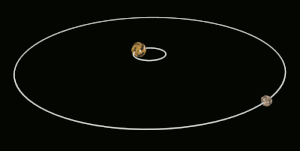Today (March 25, 1655) Another Earth, Saturn's sixth satellite Titan was discovered.

Titan was the first known Saturn
moon. Titan was discovered on March 25, 1655, by the Dutch astronomer Christian
Huygens. It is the fifth discovered moon of the planets other than Earth. Titan
(or Saturn VI) is the largest of Saturn's moons. It is the only natural
satellite known to have a dense atmosphere. And Titan is the only satellite
with evidence of stable liquid surfaces on the surface other than Earth. In
September 2012, photos taken by the Cassini satellite showed a river on Titan named the Little Nile. Titan is the sixth satellite of Saturn. Often
described as a sphere, it is 50% larger in diameter and 80% larger in mass than
Earth's moon.

Titan is the second-largest moon in the solar system after Jupiter's satellite Earth. And it is larger than Mercury, the smallest sphere in terms of capacity, although Titan contains about half the mass of Mercury. Titan was primarily made of water, ice, and rock. Research by the Cassini-Huygens satellite in 2004 revealed the presence of liquid hydrocarbon lakes in the Polar Regions beneath its dense atmosphere. It is also known to have a young topography and a large plateau with some mountains and meteorites. It is also thought to contain highly frozen volcanoes. The sphere is high in nitrogen, with methane and ethane clouds and nitrogen-rich organic smoke on its surface, as well as a variety of climates, including wind and rain.


It, therefore, has surface features similar to that of the earth, such as hills, rivers, lakes, oceans (liquid methane and ethane), and estuarine earth, and also has seasonal climates similar to those on Earth. The circulation of methane in its liquids and dense nitrogen atmosphere is thought to take place at low temperatures corresponding to the Earth's water cycle. Due to these features, it is thought that nitrogen-based organisms may have appeared here or may have been. So it is one of the most observed moons in the solar system.


Titan was discovered by the Dutch
astronomer Christian Huygens on March 25, 1655. Inspired by Galileo's discovery
of Jupiter's four large moons and telescope technology in 1610, he built his
first telescope in 1650 with the help of his brother Constantine Huygens.
Through it he discovered Titan. It was Saturn's first discovered planet. He
originally named it Saturni Luna, meaning the Moon of Saturn. John Herschel
(the discoverer of two other planets of Saturn) first used the name Titan in an
1847 book after the discovery of seven Saturn satellites. According to Greek
mythology, the name refers to Cronus and his brothers and sisters, the children
of Gaia and Uranus, who were said to have been powerful deities during the
ancient Golden Age.



Titan once orbits Saturn for 15
days and 22 hours. It is common to gaseous planets and other satellites
orbiting Saturn, so it is bound to Saturn's similar wave rotation. The
circumference of its orbit is 0.0288 and it has an inclination of 0.348 degrees.
Its surface temperature is as low as 94 Kelvin (−179.2 C). Thus it is assumed
that 1 per cent ice can be found in its upper atmosphere. There are differing
opinions that its temperature is slightly higher indoors due to the greenhouse
effect on the methane in it and that it will return all the heat due to its
dust clouds so it will still be cold indoors.
Source By: Wikipedia
Information: Dr. P. Ramesh, Assistant
Professor of Physics, Nehru Memorial College, Puthanampatti, Trichy.


.jpg)
No comments:
Post a Comment